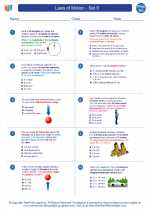Newton's Laws of Motion
Newton's laws of motion are three fundamental principles that describe the relationship between the motion of an object and the forces acting on it. These laws were formulated by Sir Isaac Newton in the 17th century and laid the foundation for classical mechanics.
First Law: Law of Inertia
The first law states that an object at rest will remain at rest, and an object in motion will continue to move at a constant velocity unless acted upon by an external force. In other words, an object resists changes in its state of motion.
Study Guide for First Law:
- Define the concept of inertia and its relationship to Newton's first law.
- Give examples of situations where the first law of motion is observed in everyday life.
- Explain the difference between mass and weight in the context of Newton's first law.
Second Law: Law of Acceleration
The second law states that the acceleration of an object is directly proportional to the net force acting on it and inversely proportional to its mass. This can be expressed as the formula F = ma, where F is the net force, m is the mass of the object, and a is the acceleration produced.
Study Guide for Second Law:
- Derive the formula F = ma from Newton's second law.
- Explain the concept of force and its units of measurement.
- Discuss how the second law explains the motion of objects of different masses under the influence of the same force.
Third Law: Law of Action-Reaction
The third law states that for every action, there is an equal and opposite reaction. When one object exerts a force on a second object, the second object exerts an equal and opposite force on the first object.
Study Guide for Third Law:
- Provide examples to illustrate Newton's third law of motion.
- Explain how action-reaction pairs act on different objects in different situations.
- Discuss the implications of the third law in the context of everyday phenomena, such as vehicle propulsion and rocketry.
Understanding and applying Newton's laws of motion is essential for analyzing and predicting the behavior of objects in motion. Mastering these fundamental principles provides a solid foundation for further studies in physics and engineering.
Now that you have a study guide for Newton's laws of motion, I suggest reviewing each law, practicing related problems, and discussing the concepts with peers or a tutor to ensure a thorough understanding of the topic.
.◂Physics Worksheets and Study Guides High School. Laws of Motion - Set II

 Worksheet/Answer key
Worksheet/Answer key
 Worksheet/Answer key
Worksheet/Answer key
